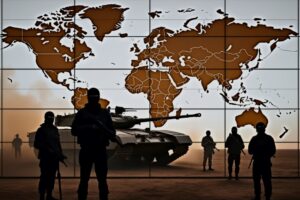
With the world entering an era of rising geopolitical unrest, the Ukraine and Gaza wars stand out as striking examples of reckless miscalculation. Russia’s 2022 invasion and the Hamas assault on October 7 both resulted in disastrous outcomes for the aggressors.
Each case reflected a willingness to take extreme geopolitical risks, coupled with a profound misreading of the strategic map. Both events also highlighted the dangers of strategic arrogance.
The ill-fated invasions by Russia and Hamas ushered an age of global turmoil, where some leaders are prone to taking wild risks based on flawed assessments. In this increasingly unstable world, more reckless gambles may be coming up.
Don’t underestimate your rivals
When Russian forces rolled into Ukraine, the Kremlin believed that the Ukrainian military would fold with minimal resistance. The assumption was that Kyiv would be captured within days, leading to a swift victory. Instead, Ukrainian forces proved far more resilient, fueled by fierce national pride and bolstered by substantial international support.
Moreover, Moscow entered the conflict believing it had a world-class military that could project its power with relative ease. But as the months dragged on, the cracks in Russia’s military capabilities became glaringly obvious.
Logistic problems, low morale, and outdated tactics exposed a force far less competent than expected, leading to significant battlefield losses. The military setbacks and coordinated international response left Russia largely isolated and its economy battered.
Hamas similarly miscalculated, assessing that its brutal attack would trigger a harsh but limited Israeli response. The internal divisions within Israel likely contributed to a misguided belief that the IDF had no capacity to fight a prolonged, full-scale war in Gaza.
As it turned out, Israel’s counterattack has been overwhelming and more extensive than Gaza’s terror chiefs anticipated.
Hamas also overestimated its capacity to withstand the inevitable retaliation. The mass invasion from Gaza was neutralized in days, followed by a devastating military campaign that destroyed the Gaza terror base and wiped out most of Hamas’ leadership.
The echo chamber effect
Another similarity between Russia and Hamas is their reliance on controlled media environments, or even echo chambers, that feed false perceptions.
In Russia, state-controlled media glorified the Russian military while downplaying Ukrainian resistance, painting a narrative of inevitable success in the face of a weak West. This fed into President Putin’s false confidence, reinforced by a small circle of cronies, leading him to believe the war would be a quick affair.

Hamas, too, operates in a closed and highly ideological environment. In this bubble, Gaza’s terror leaders came to believe that the October 7 assault would elicit widespread Arab support, inspiring uprisings on other fronts and likely igniting a regional conflict.
Instead, Hamas was left largely isolated, with regional allies hesitating to enter the conflict in full force. In retrospect, both Russia and Hamas are textbook examples of controlled or ideologically insulated environments leading to poor decision-making.
Deeper geopolitical trends
The events in Ukraine and Gaza reflect deeper trends in the current geopolitical landscape. A key factor is the growing sense that the global order is in flux.
In particular, the American superpower has been perceived as more inward-looking and vulnerable in recent years (especially after the withdrawal from Afghanistan). In this multi-polar world, some countries and groups seem more willing to make bold, high-risk moves.
This can be seen in the actions of both state actors (like Russia) and non-state actors (like Hamas), who see this period of geopolitical disorder as an opportunity to reshape the regional or global landscape to their advantage.
And so, Moscow viewed the weakening of Western resolve as an opening for aggressive steps in Ukraine. Similarly, Hamas likely saw shifting dynamics in the Middle East as an opportunity to disrupt the status quo.
Ultimately, the underlying geopolitical instability seems to be encouraging actors to take bigger, riskier gambles, even when lacking a solid understanding of their own capabilities or those of their rivals.
Compounding this is the increasing role of information control and propaganda in authoritarian regimes. Leaders surrounded by “yes-men” or reliant on narrow sources of info may fall into the trap of believing their own narratives of strength, only to face harsh realities when their plans meet the battlefield.
A more dangerous world
Russia’s and Hamas’ miscalculations reflect deeper, troubling tendencies in the world today. The interconnected nature of the global system means that conflicts triggered by catastrophic misjudgments can have a far-reaching impact on geopolitics, economics, and regional security.
Notably, strategic errors of this magnitude are not unique to the current era. History is littered with instances where leaders misread their opponents and overestimated their own strength, with disastrous consequences.
Hitler’s decision to invade the Soviet Union in 1941 ultimately played a crucial role in the Nazis’ downfall. The German dictator underestimated Soviet resilience and the harshness of the Russian winter, a grave mistake that turned the tide of World War II.
Similarly, Japan believed a knockout blow at Pearl Harbor would cripple American resolve and force the US into a favorable settlement. Instead, it awakened a sleeping giant, sealing Japan’s eventual defeat.
As history has shown time and again, taking reckless geopolitical risks on a grand scale can trigger far-reaching effects. Just like in the past, the current age of global unrest could reshape the world in unpredictable ways.


